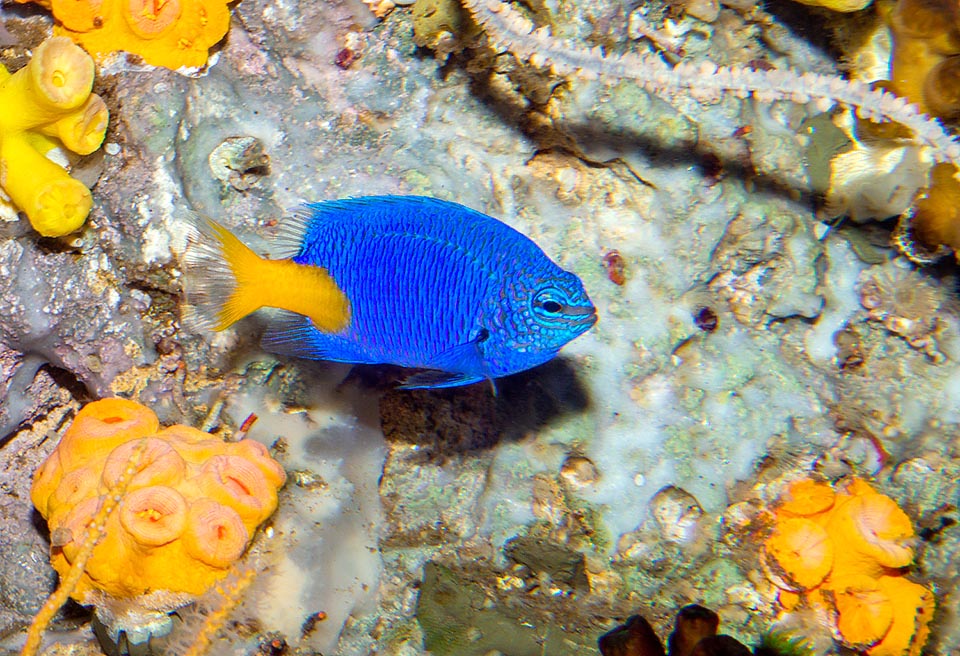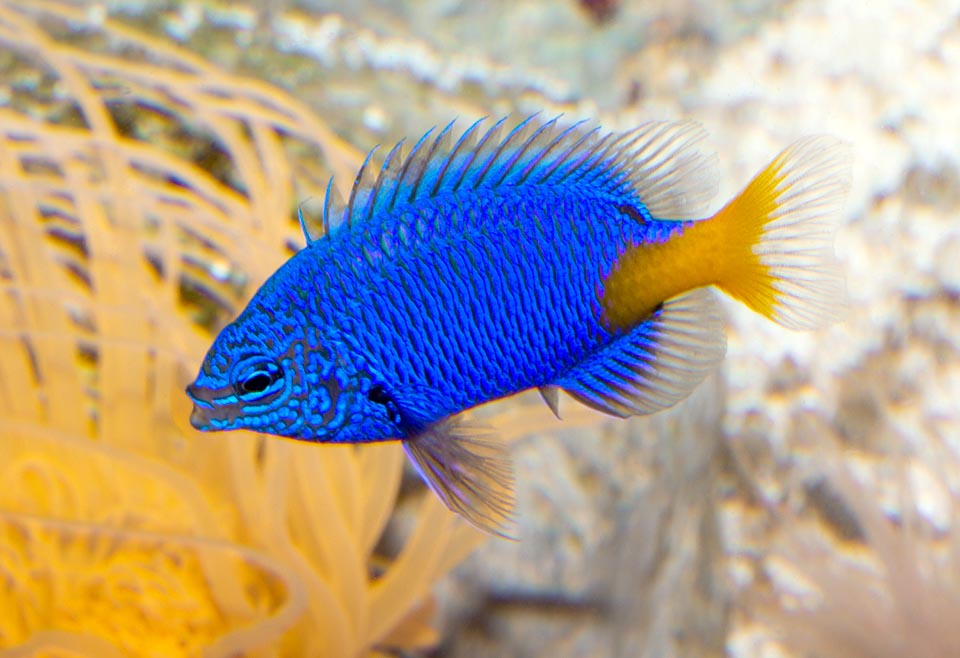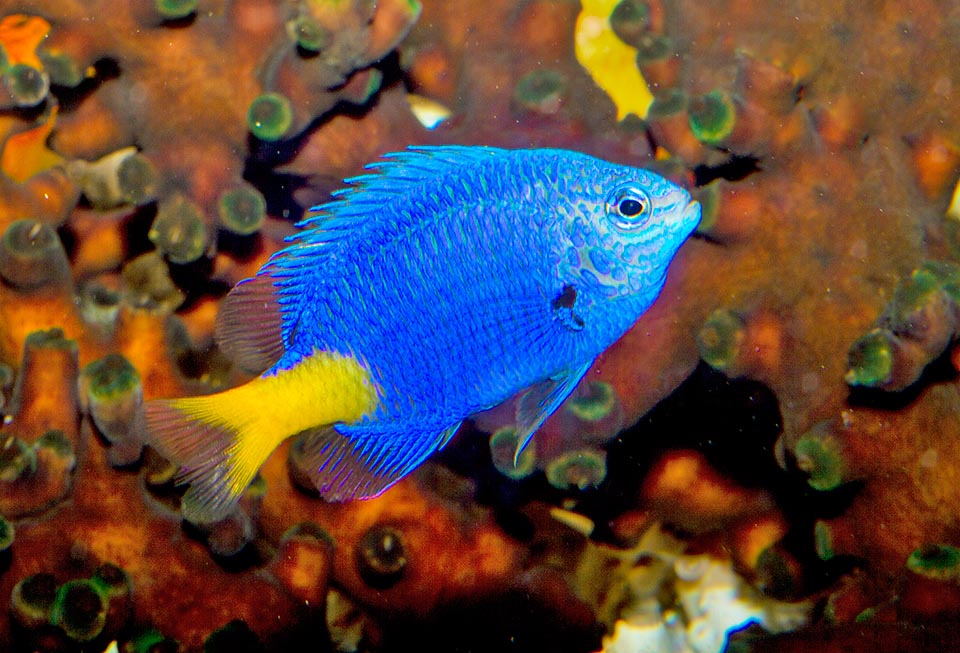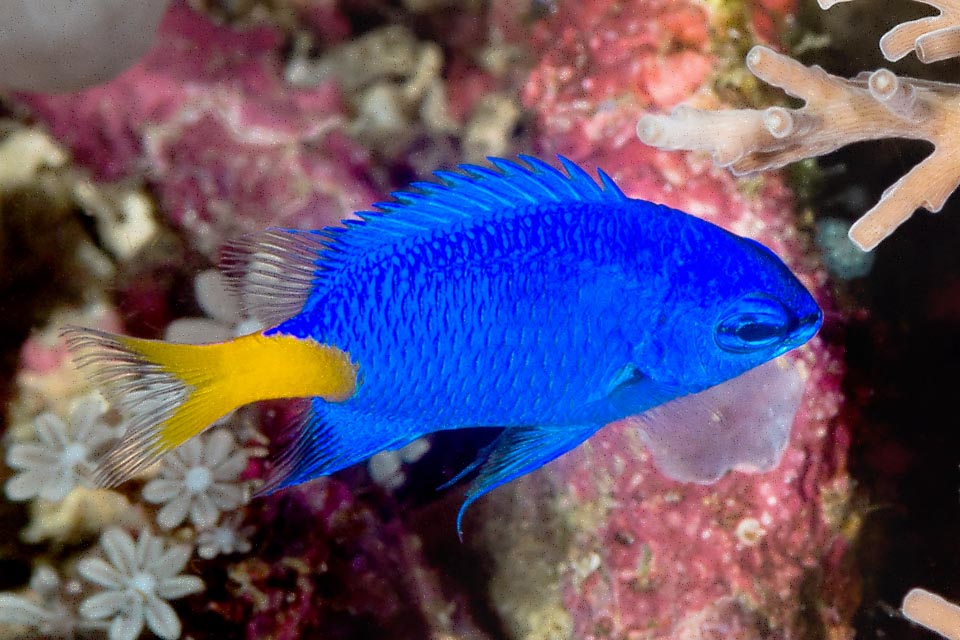Family : Pomacentridae

Text © Giuseppe Mazza

English translation by Mario Beltramini

Long 7 cm at most, the Chrysiptera parasema is present, in shallow waters, in the madreporic formations of western Pacific Ocean © Giuseppe Mazza
The Chrysiptera parasema (Fowler, 1918), known also as Yellowtail blue damsel or Goldtail demoiselle, belongs to the class of the Actinopterygii, the ray-finned fishes, to the order of the Perciformes and to the family of the Pomacentridae that hosts more than 400 species, among which the famous clownfishes and the damselfishes.
The name of the genus Chrysiptera comes from the Greek “χρυσός” (khrusos) = gold and “πτερόν” (pterón) = wing, fin, due to the golden caudal fin, whilst that of the species, parasema, comes, then Latinized in “parasemum”, always from the Greek “παρασημα” (parasēmon), word formed by “παρα” (para) and “σημα” (sēma) = sign, with reference to the colour of the fish, rightly called in biology parasematic, because with its showy yellow tail distracts from the head the attention of the predators addressing them towards the tail, a non vital organ.
Zoogeography
The Chrysiptera parasema is mainly present in the tropical waters of western Pacific. We find it, indicatively, in Malaysia, Indonesia, Philippines, Vietnam, RyuKyu Islands, Palau, Papua New Guinea and Solomon Islands.

It has spiny dorsal and anal rays, but mainly saves itself due to the showy contrast of the body-tail colour, a non-vital organ that the predators mistake for the head © Giuseppe Mazza
Ecology-Habitat
It is a species linked to the madreporic formations that lives in shallow waters, between 1-16 m of depth, often protected by anthozoans of the genus Acropora that offer a good shelter with their fanciful pointed ramifications or with overlapping horizontal plaques. It loves the calm waters of the lagoons and the coral reefs along the coasts.
Morphophysiology
The Chrysiptera parasema does not exceed the 7 cm. The body is flattened laterally. The head, small and pointed. The mouth, protractile, is armed with very sharp tiny thin teeth.
The dorsal fin, erectile when it feels menaced, has 13 spiny rays and 10-12soft. The pectoral ones, translucent, have 14-15 rays and are unarmed as the pelvic.

The eggs, monitored and ventilated by the male, are glued to the seabed. Easy to nourish, it reproduces even in modestly sized aquaria, but then the larvae die of hunger. © Giuseppe Mazza
The caudal peduncle and adjacent zones are of a nice intense yellow that contrasts shaply with the glittering electric blue colour of the body and this is the element that characterizes the species distinguishing it from others quite similar, such as Chrysiptera arnazae, Chrysiptera cyanea, Chrysiptera giti, Chrysiptera hemicyanea and Chrysiptera starcki.
To complicate the things, apart the hybrids, the Chrysiptera parasema may have some yellow also on the pelvic fins and on the back part of the dorsal and anal fins.
We have to add that, depending on the environment and the mood, the fish can lighten or intensify the blue, almost up to the black, when, scared, it hides in a small grotto, and that the scales create iridescent effects.
Also Chrysiptera cymatilis and Chrysiptera springeri have a similar apperance but here the yellow is completely absent.
Ethology-Reproductive Biology
The Yellowtail blue damsel is a diurnal species practically omnivorous.

The adults, easy to feed, adapt well to the life in captivity and in nature is not an endangered species © François Libert
It nourishes of plankton, algae and small benthic crustaceans it finds among the corals. The adults usually swim alone or in couple, whilst the young move in small schools.
The males are territorial. The females may lay even 300 eggs glued to the bottom in a nest surveyed and aerated by the male for 3-4 days, till the hatch.
It is a fish that well adapts to the aquarium life. Easy to feed, it is less quarrelsome and less territorial than other congeners. It couples and can spawn even in pools of modest size, but then the larvae, extremely small, starve to death.
The Chrysiptera parasema is not now (2020) an endangered species. In case of need, the populations may rapidly double in less than 15 months their members and the vulnerability index marks only 14 on a scale of 100.
Synonyms
Abudefduf parasema Fowler, 1918.
→ For general information about FISH please click here.
→ For general information about BONY FISH please click here
→ For general information about CARTILAGINOUS FISH please click here.
→ To appreciate the BIODIVERSITY of BONY FISH please click here.
→ To appreciate the BIODIVERSITY of CARTILAGINOUS FISH please click here.
